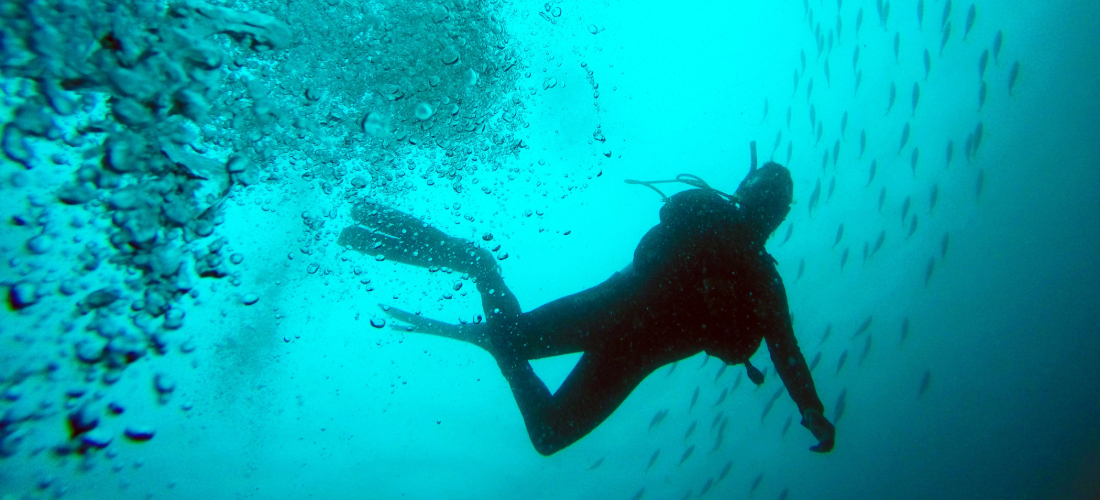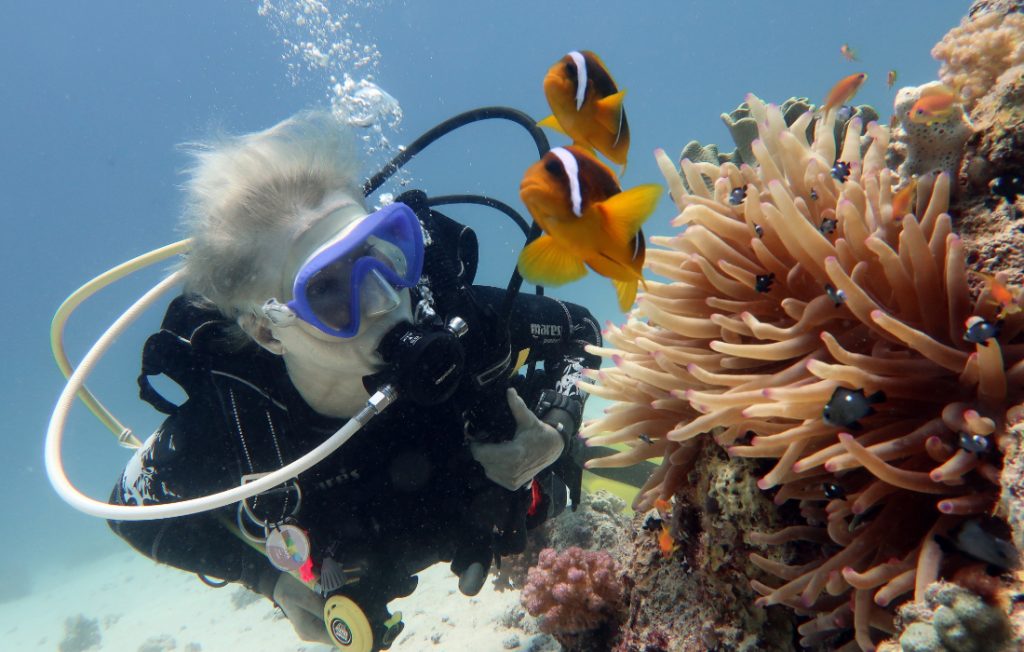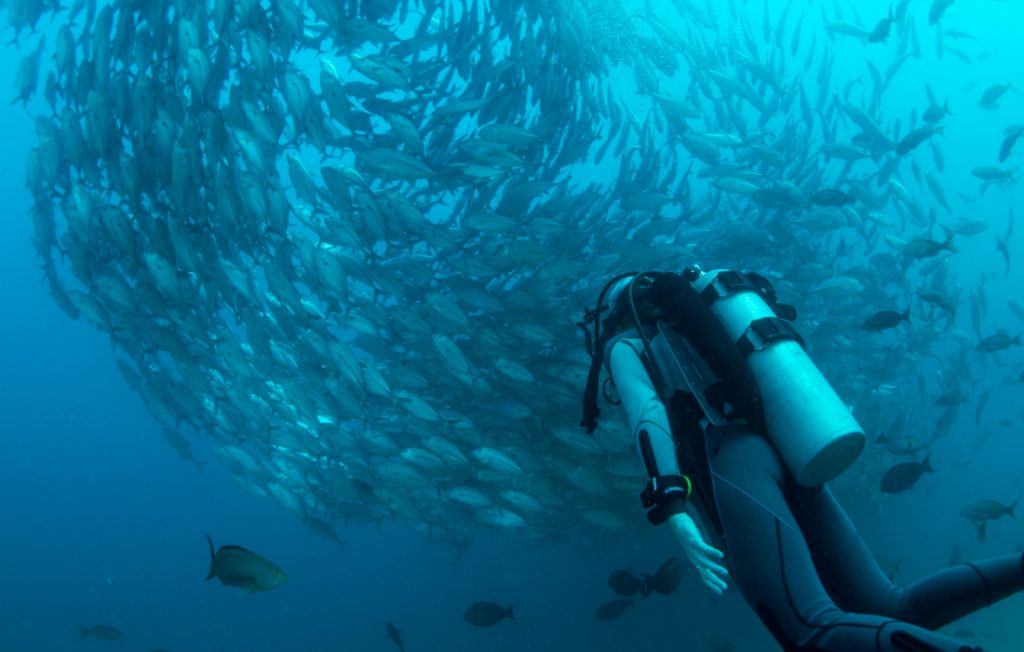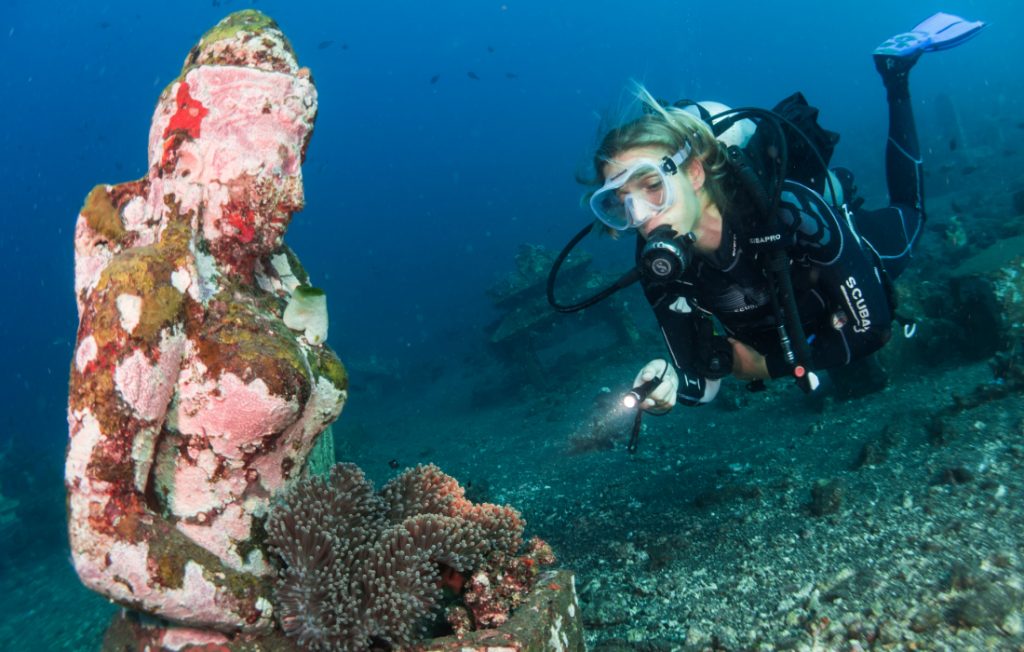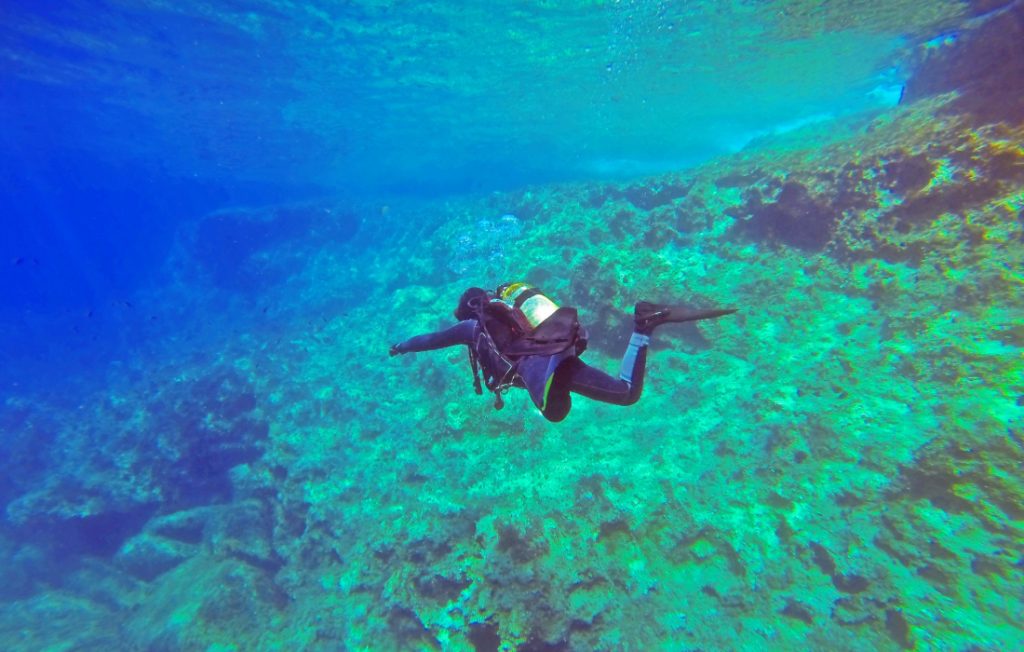So, you’ve decided it’s about time you experienced what it’s like to breathe underwater. Your first dives are something to be remembered, which is why you should pick your destination and dive school wisely. Before planning your first-ever diving vacation, take a look at some of the best places to learn to scuba dive. The following regions offer great diving conditions for novices, easy dive sites, and dazzling underwater life.
1. Egypt
It probably comes as no surprise that we’ve included Egypt on our list of best places to learn to scuba dive. This iconic destination is one of the most affordable places to get your scuba certification and diving here is nothing short of legendary. Sharm El-Sheikh and Dahab are both excellent diving destinations for beginners.
Diving Highlights: The sheer abundance of corals (more than 400 species of coral have been recorded here) makes diving in the Sinai Peninsula area an unforgettable experience, but there’s also a notable variety of marine animal species. Divers can spot hammerhead sharks, white-tip sharks, thresher sharks, Napoleon wrasses, giant manta rays, groupers, among many other sea creatures.
Best Time for Diving: While diving in the Red Sea is possible throughout the year, there are some variations in air and water temperatures you may want to consider. During the winter months of December, January, and February, the water temperature averages about 22° C/71° F and then it slowly increases up to 28° C/82° F in June, August, and September. If you don’t care about the extreme heat during the summer, then visit between May and August for the best diving conditions.
Diving Conditions: The visibility is great year-round, even exceeding 30 meters/100 feet at some dive sites. The water is warm during the summer and not that bad during the winter. As for the current, it’s generally gentle except for some drift dives and wreck dives which you may not yet be able to enjoy until you gain a bit more experience.
2. Roatan
Roatan is a great place for beginner divers to test the waters. Although small, the island has something for everyone. There are dozens of unique dive sites to choose from, and among them are plenty of sheltered spots suitable for novices. Plus, there are plenty of things to see during your surface time on this little piece of (Caribbean) heaven.
Diving Highlights: Roatan is renowned for its remarkable reef. The Mesoamerican Barrier Reef runs along the coast of the island and features an array of vibrant corals and sponges. When it comes to marine life, the whale sharks and hammerheads are probably the highlights of the area, but nurse sharks, sea turtles, moray eels, seahorses, and the numerous critters are quite a sight as well.
Best Time for Diving: The weather in Roatan is warmest and driest in April and May, but you can safely visit from February to September and find good diving conditions. Mid-February through April offers the best chances of seeing whale sharks.
The rainy season typically runs from October to January and it usually negatively impacts visibility.
Diving Conditions: The visibility in Roatan is excellent, often exceeding 40 meters (131 feet), and the water temperature averages 28° C/82°. The island has mostly mild currents and calm surface conditions that are perfect for novices.
3. Utila

Photo by Scubaben
Like its neighbor Roatan, Utila is a small island in Honduras’ Bay Islands that’s become a favorite destination among those that are looking to take their Open Water course. As one of the best places to learn to scuba dive, it offers a multitude of reliable dive centers and the prices here are some of the lowest you’ll find in the Caribbean.
Diving Highlights: Utila’s most famous diving attraction is without a doubt the whale shark. But with over 200 species of marine animals to be found here, you’ll have plenty to see. Spotted eagle rays, yellow stingrays, Hawksbill turtles, dolphins, queen angelfish, longlure frogfish, and longsnout seahorses are quite a sight as well.
Best Time for Diving: The weather is consistently good year long, but it would be best to avoid the rainy season that usually lasts from October to January. And while there are chances of seeing whale sharks year-round, March-April is considered the main whale shark season in Utila. This is when most people come here to get up close to the largest fish in the world.
Diving Conditions: Utila offers excellent diving conditions, with its great visibility of 30-45 meters (100-150 feet) on many of the dive sites and mostly mild currents. The water temperature is warm throughout the year, ranging from 25° C/78° F to 28° C/82° F.
4. Mexico
Mexico is a premier diving destination, with many excellent dive centers offering certification courses at competitive prices. There are many regions throughout the country with relaxed diving conditions that create the perfect means for novices to break the water for the first time. From the world-renowned Cozumel off the mainland peninsula of Yucatán and Quintana Roo to Cabo Pulmo and the Isla Espíritu Santo, there are plenty of diving destinations within the country suitable for beginners.
Diving Highlights: Whales, whale sharks, hammerhead sharks, manta rays, dolphins, and schooling fish can all be found here. There’s also a multitude of types of diving you can enjoy such as drift diving, reef diving, wall diving, and even cage diving. Furthermore, if you’re visiting the state of Quintana Roo, you can even dive in the first section of a cenote, as you don’t need an Advanced Open Water certification for cavern diving.
Best Time for Diving: Diving in Mexico is possible year-round, but you’ll experience different seasons within the country depending on location. The Caribbean side offers better weather (and calmer diving conditions) throughout the year. On the Pacific side, the warmest waters and better visibility can be found from June to October, but the big pelagics usually visit the area from November to May.
Diving Conditions: Divers can expect fairly steady diving conditions throughout the year on the Caribbean side. It’s also the area most suitable for beginners. Plus, the visibility often exceeds 30 meters (100 feet), especially in the cenotes.
The Pacific coast is typically recommended for intermediate to advanced divers, although there are still plenty of easy dive sites where everyone can dive safely.
5. Indonesia
With more than 17,000 islands scattered over an area of great biodiversity known as the Coral Triangle, Indonesia holds many surprises for divers of all levels of experience. Bali, in particular, stands out as one of the best places to learn to scuba dive, along with the Gili Islands, Bangka Island, and Belitung Island. The costs of obtaining your basic certification are also quite affordable.
Diving Highlights: The Indonesian waters contain about 76% of the species of coral and 37% of the species of coral reef fish found in the world. Some of the highlights of your diving experience here would be the encounters with the unusual-looking Mola Molas (or ocean sunfish), reef manta rays, and the many different species of sea turtles. The dazzling underwater coral gardens include staghorn corals, table corals, massive starlet corals, and black corals.
Best Time for Diving: Diving in Indonesia is excellent throughout the year, but it would be best to avoid the monsoon season (May to September) as it can negatively impact the diving conditions. Certain particularities may apply to each region within the country, so do a bit more research on the destination you plan on visiting.
Diving Conditions: Thanks to it being a tropical country, the climate is fairly even throughout the year. The water temperature exceeds 20°C/68°F even in the coldest month, while the visibility and currents vary greatly from island to island. Nonetheless, you should have no issue finding dive sites with excellent visibility and calm seas in popular regions among novices such as Bali. You may want to hold off on the spectacular Raja Ampat until you gain more experience.
6. The Philippines
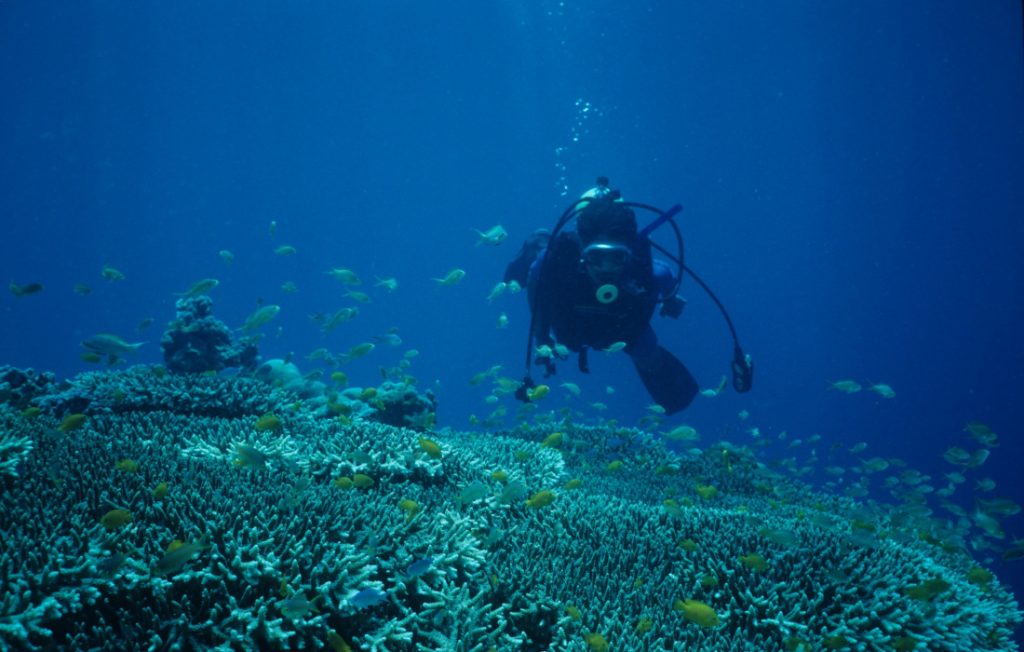
Photo by Derek Keats
Also part of the Coral Triangle, The Philippines boasts one of the richest marine concentrations of marine life on Earth. The country comprises over 7,000 islands, so the perfect destination to learn new diving skills is surely out there. It’s not only one of the best places to learn to scuba dive but it’s also among the most affordable to do so. Malapascua Island, Verde Island, Mindoro Island, and the Palawan Archipelago are all perfect regions for beginners.
Diving Highlights: With over 400 species of coral and 1200 species of marine animals, The Philippines is one of the most biodiverse regions on Earth. It’s one of the best areas for spotting barracudas, Moorish idols, emperor fish, moray eels, pygmy seahorses, mantis shrimps, but also big pelagics such as whale sharks, eagle rays, manta rays, and hammerhead sharks. There’s also a variety of warships and planes that lie in shallow depth, so even beginners can enjoy wreck diving here.
Best Time for Diving: November through April is usually the best time to dive in The Philippines, with mostly dry weather and calm conditions. The rainy season hits the different regions within the country at different times of the year, so research your destination when planning the trip.
Diving Conditions: The visibility, water temperatures, and currents vary tremendously depending on the location and the weather. The visibility ranges from 5 to 45 meters (15-150 feet) while the water temperature falls between 23-30° C/73-86° F. As for the currents, you’ll find strong currents at some of the locations but there are also plenty of sheltered dive sites that are perfect for novices.
7. Malta
If you’re based in Europe and don’t want to travel too far to learn how to scuba dive, then Malta is a perfect choice. The Maltese Islands offer a wide selection of dive centers with qualified diving staff. The dive centers are located across all islands within the archipelago: Malta, Gozo, and Comino. There are lots of shallow dive sites – including some interesting wrecks – that beginners can explore.
Diving Highlights: Thanks to its warm Mediterranean waters, Malta has a variety of underwater flora and fauna. The gardens of seagrass and stunning artificial reefs are home to a number of sea creatures. The marine animals you are most likely to see here include groupers, stingrays, parrotfish, amberjacks, scorpionfish, sea urchins, moray eels, octopuses, and rare sights include dolphins, tunas, and bonitos.
Best Time for Diving: The peak season for diving in Malta runs from June through September, when the weather is dry and warm. Nonetheless, it is possible to enjoy equally great diving from April to early October.
Diving Conditions: The calmness of the Mediterranean Sea has created a diving haven with great visibility of 20 to 40 meters (66-131 feet). The water temperature usually doesn’t drop below 15° C/59° F, and during the summer months it peaks at about 26° C/79° F. The currents are usually weak except for a few deeper dive sites.
8. Florida

Photo by Matt Kieffer
Florida is renowned for being U.S.’s diving state. Florida Keys, in particular, is one of the best places to learn to scuba dive in the States if want to dive locally and at the same time enjoy the closest thing to an exotic experience within the country. The Keys are a string of tropical islands in the Atlantic Ocean where you can see many of the usual marine life found in the Caribbean Sea. There are many dive schools in both the Keys and continental Florida offering affordable diving packages.
Diving Highlights: Florida’s waters contain an array of marine animals, from big pelagics such as whales, sailfish, different species of sharks, and sea turtles to butterflyfish and parrotfish. The Florida Reef, which is the only living coral barrier reef in continental U.S., lies a few miles seaward of the Florida Keys and consists of stony corals, brain corals, star corals, gorgonians, and staghorn coral, among other species.
Best Time for Diving: Scuba diving is possible year-round in Florida because you have different locations to choose from. The west coast offers warm temperatures throughout the year with the exception of a few months of cool winter weather. The east coast has a humid, subtropical while the southern tip has a tropical climate with rainfall from May to October.
Diving Conditions: In the Keys, the water temperatures range from 21° C/69° F during winter to 30° C/86° F during summer. It gets cooler the further north you go, but you’ll still enjoy pleasant temperatures if you come during the right time of the year. The visibility and currents are also largely dependent on the weather, so it’s best to contact the dive center you decided on to learn more about the diving conditions in the region you’re traveling to.
Before choosing the place where you’ll be dipping your fins in the water for the first time, you may want to answer a few questions to make sure you’re making the right choice: How far are you willing to travel? What’s your budget? What are you expecting to see underwater?
There are plenty of regions suitable for beginners throughout the world, so whether you choose to remain close to home or travel far and beyond, you’ll still be able to fulfill your dream of learning to scuba dive and get certified.
